AMAZON multi-meters discounts AMAZON oscilloscope discounts
Cont. from part 1
Direct Current Motors
Direct-current motors are not used as much as alternating current types because all electric utility systems deliver alternating current. For special applications, however, it’s advantageous to transform the alternating current into direct current in order to use DC motors. Direct-current motors are used where a wide range of precise torque and speed control is required to match the needs of the application. Such applications include cranes, conveyors, and elevators.
The construction of a DC motor is considerably more complicated and expensive than that of an AC motor, primarily because of the commutator, brushes, and armature windings. Maintenance of the brush/commutator assembly found on DC motors is significant compared to that of AC motor designs. An AC induction motor requires no commutator or brushes, and most use cast squirrel-cage rotor bars instead of wound copper wire windings. There are several types of DC motors, classified according to field type. These are permanent magnet, series, shunt, and compound.
Motor speed, torque, and horsepower (hp) are important parameters used to predict DC motor performance:
Speed: Refers to the rotational speed of the motor's shaft and is measured in revolutions per minute (rpm).
Torque: Refers to the turning force supplied by the motor's shaft. Torque consists of force acting on a radius. The standard units of torque as used in the motor control industry are pound-inches (lb-in), or pound-feet (lb-ft).
Horsepower: Refers to the rate at which work is done. As an example, 1 horsepower is equivalent to lifting 33,000lbs to a height of 1 foot in 1 minute.
One horsepower is also equivalent to 746 watts of electrical power. Therefore, you can use watts to calculate horsepower and vice versa.

Ill. 9 Major components of a DC motor. Brush; Stator Frame; End bracket;
Shaft assembly; Bearings; Commutator; Armature
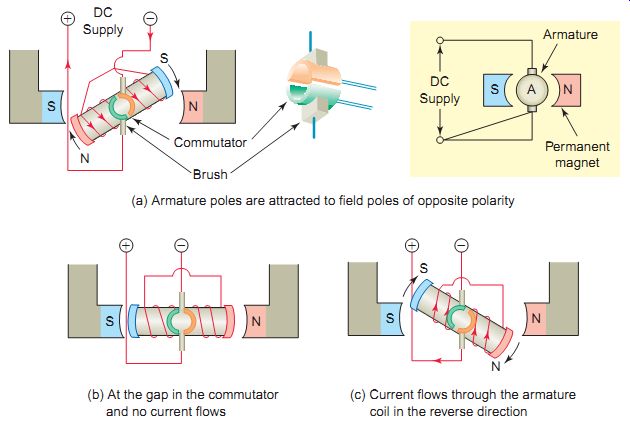
Ill. 10 Permanent-magnet DC motor operation. (a) Armature poles are
attracted to field poles of opposite polarity. (b) At the gap in the commutator
and no current flows. (c) Current flows through the armature coil in the
reverse direction.

Ill. 11 Permanent-magnet DC motor. Permanent-magnet field; Armature
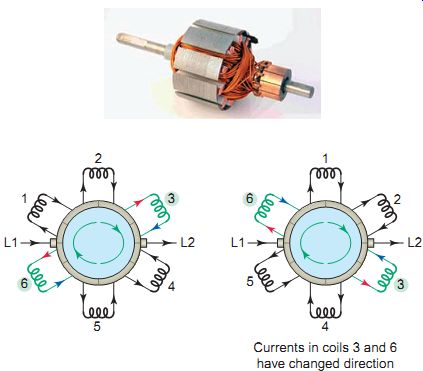
Ill. 12 Armature commutation or switching effect. Currents in coils 3
and 6 have changed direction
Permanent-Magnet DC Motor
Permanent-magnet DC motors use permanent magnets to supply the main field flux and electromagnets to pro vide the armature flux. Movement of the magnetic field of the armature is achieved by switching current between coils within the motor. This action is called commutation. Ill. 10 illustrates the operation of a simple permanent-magnet motor. The operation of the circuit can be summarized as follows:
• Current flow through the armature coil from the DC voltage supply causes the armature to act as an electromagnet.
• The armature poles are attracted to field poles of opposite polarity causing the armature to rotate in a clockwise direction.
• When the armature poles are in line with the field poles, the brushes are at the gap in the commutator and no current flows in the armature. At this point the forces of magnetic attraction and repulsion stop and inertia carries the armature past this neutral point.
• Once past the neutral point, current flows through the armature coil in the reverse direction because of the commutator’s reversing action. This in turn reverses the polarity of the armature poles, resulting in repulsion of the like poles and further rotation in a clockwise direction.
• The cycle is repeated with the current flow through the armature reversed by the commutator once each cycle to produce a continuous rotation of the armature in a clockwise direction.
Ill. 11 shows a permanent-magnet (PM) DC motor. The motor is made up of two main parts: a housing containing the field magnets and an armature consisting of coils of wire wound in slots in an iron core and connected to a commutator. Brushes, in contact with the commutator, carry current to the coils. PM motors produce high torque compared to wound-field motors. However permanent magnet motors are limited in load-handling ability and for this reason used mainly for low-horsepower applications.
The force that rotates the motor armature is the result of the interaction between two magnetic fields (the stator field and the armature field). To produce a constant torque from the motor, these two fields must remain constant in magnitude and in relative orientation. This is achieved by constructing the armature as a series of small sections connected to the segments of a commutator. Electrical connection is made to the commutator by means of two brushes. It can be seen that if the armature rotates through one-sixth of a revolution clock wise, the current in coils 3 and 6 will have changed direction. As successive commutator segments pass the brushes, the current in the coils connected to those segments changes direction. The commutator can be regarded as a switch that maintains the proper direction of current in the armature coils to produce constant unidirectional torque.
The direction of rotation of a permanent-magnet DC motor is determined by the direction of the current flow through the armature. Reversing the polarity of the voltage applied to the armature will reverse the direction of rotation. Variable-speed control of a PM motor is accomplished by varying the value of the voltage applied to the armature. The speed of the motor varies directly with the amount of armature voltage applied. The higher the value of the armature volt age, the faster the motor will run.
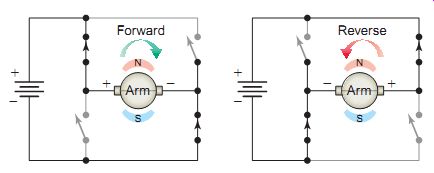
Ill. 13 Reversing the direction of rotation of a PM motor.
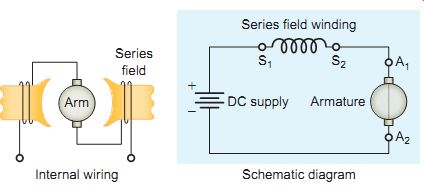
Ill. 14 Series-type DC motor. Series field; Internal wiring; Series
field winding; Schematic diagram; DC supply; Armature
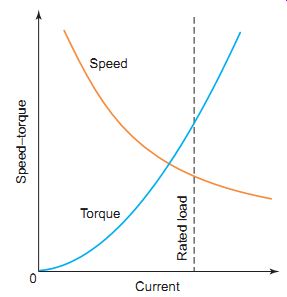
Ill. 15 Speed-torque characteristic curves for a series DC motor.
Series DC Motor
Wound-field DC motors are usually classified as series wound, shunt-wound, or compound-wound. The connection for a series-type DC motor is illustrated.
A series-wound DC motor consists of a series field winding (identified by the symbols S1 and S2) connected in series with the armature (identified by the symbols A1 and A2). Since the series field winding is connected in series with the armature, it will carry the same amount of cur rent that passes through the armature. For this reason the windings of the series field are made from heavy-gauge wire that is large enough to carry the full motor load cur rent. Because of the large diameter of the series winding, the winding will have only a few turns of wire and a very low resistance value.
A series-wound DC motor has a low resistance field and low resistance armature circuit. Because of this, when voltage is first applied to it, the current is high ( I = E/R ). The advantage of high current is that the magnetic fields inside the motor are strong, producing high torque (turning force), so it’s ideal for starting very heavy mechanical loads. Ill. 15 shows the speed-torque characteristic curves for a series DC motor. Note that the speed varies widely between no load and rated load. Therefore, these motors cannot be used where a constant speed is required with variable loads. Also the motor runs fast with a light load (low current) and runs substantially slower as the motor load increases. Because of their ability to start very heavy loads series motors are often used in cranes, hoists, and elevators, which can draw thousands of amperes on starting. Caution: The no-load speed of a series motor can increase to the point of damaging the motor. For this reason, it should never be operated without a load of some type coupled to it.
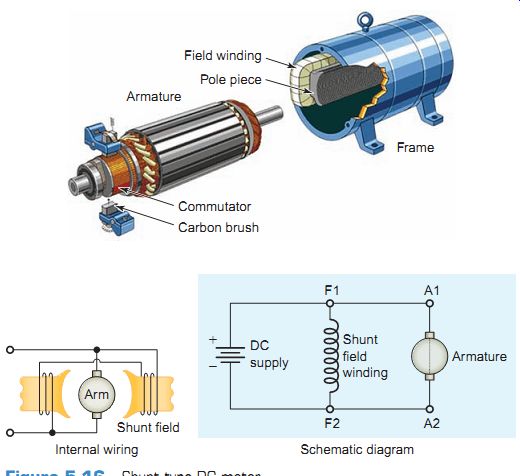
Ill.
16 Shunt-type DC motor. Field winding Pole piece Frame Commutator Carbon
brush Armature

Ill. 17 Speed-torque characteristic curves for a shunt DC motor. Typical
shunt-wound DC conveyor motor; Current; Rated load; Speed; Torque; Speed/torque
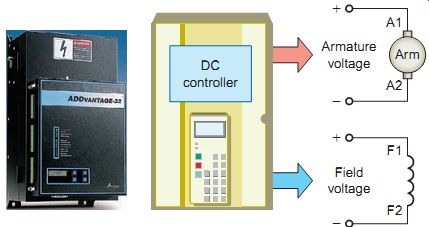
Ill. 18 Separately excited shunt motor. Armature voltage; Field voltage
Shunt DC Motor
The connection for a shunt-type DC motor is illustrated in Ill. 16. A shunt-wound DC motor consists of a shunt field (identified by the symbols F1 and F2) connected in parallel with the armature. This motor is called a shunt motor because the field is in parallel to, or "shunts," the armature. The shunt field winding is made up of many turns of small-gauge wire and has a much higher resistance and lower current flow compared to a series field winding.
Ill. 17 shows the speed-torque characteristic curves for a shunt DC motor. Since the field winding is connected directly across the power supply, the current through the field is constant. The field current does not vary with motor speed, as in the series motor and, there fore, the torque of the shunt motor will vary only with the current through the armature. When the motor is starting and speed is very low, the motor has very little torque.
After the motor reaches full rpm, its torque is at its fullest potential. One of the main advantages of a shunt motor is its constant speed. It runs almost as fast fully loaded as it does with no load. Also, unlike the series motor, the shunt motor won’t accelerate to a high speed when no load is coupled to it. Shunt motors are particularly suitable for applications such as conveyors where constant speed is desired and high starting torque is not needed.
The field winding of a shunt motor can be separately excited or connected to the same voltage source as the armature. Ill. 18 shows the connection for a separately excited shunt motor. An advantage to separately exciting the shunt field is that a variable-speed DC drive can be used to provide independent control of the field and armature.
Compound DC Motor
A compound-wound DC motor is a combination of the shunt-wound and series-wound types. This type of DC motor has two field windings.
One is a shunt field connected in parallel with the armature; the other is a series field that is connected in series with the armature. The shunt field gives this type of motor the constant-speed advantage of a regular shunt motor. The series field gives it the advantage of being able to develop a large torque when the motor is started under a heavy load.
This motor is normally connected cumulative-compound so that under load the series field flux and shunt field act in the same direction to strengthen the total field flux.
Ill. 20 shows a comparison of speed-torque characteristic curves for a cumulative compound DC motor versus series and shunt types. The speed of the compound motor varies a little more than that of shunt motors, but not as much as that of series motors. Also, compound type DC motors have a fairly large starting torque-much more than shunt motors, but less than series motors. The shunt winding can be wired as a cumulative long-shunt or as a short-shunt compound motor. For short-shunt, the shunt field is connected in parallel with only the armature, whereas with long-shunt the shunt field is connected in parallel with both the series field and the armature. There is very little difference in the operating characteristics of long-shunt and short-shunt compound motors. These motors are generally used where severe starting conditions are met and constant speed is required at the same time.
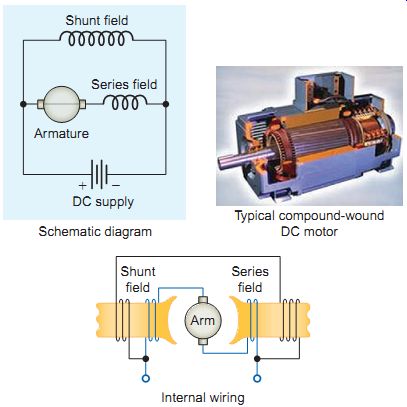
Ill. 19 Compound-type DC motor. Schematic diagram DC supply; Armature;
Series field; Shunt field; Series field; Shunt field; Arm; Internal wiring;
Typical compound-wound DC motor
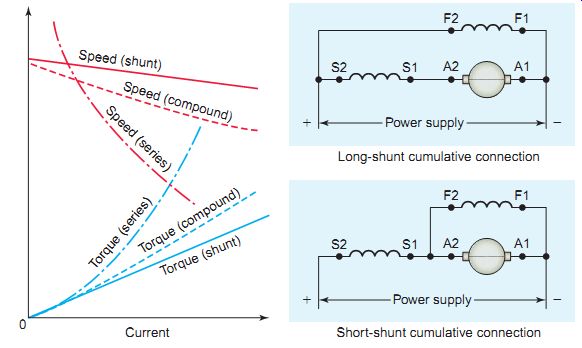
Ill. 20 DC cumulative compound motor connections and speed-torque characteristics.
Long-shunt cumulative connection; Short-shunt cumulative connection;
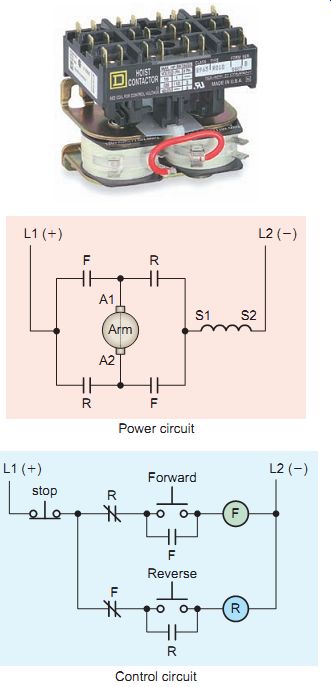
Ill. 21 DC series motor reversing motor starter.

Ill. 22 DC shunt and compound motor reversing. Shunt motor; Compound
motor
Direction of Rotation
The direction of rotation of a wound DC motor depends on the direction of the field and the direction of the cur rent flow through the armature. If either the direction of the field current or the direction of the current flow through the armature of a wound DC motor is reversed, the rotation of the motor will reverse. If both of these two factors are reversed at the same time, however, the motor will continue rotating in the same direction.
For a series-wound DC motor, changing the polarity of either the armature or series field winding changes the direction of rotation. If you simply changed the polarity of the applied voltage, you would be changing the polarity of both series field and armature windings and the motor's rotation would remain the same.
Ill. 21 shows the power and control circuit schematics for a typical DC reversing motor starter used to operate a series motor in the forward and reverse directions. In this application, reversing the polarity of the armature voltage changes the direction of rotation. The operation of the circuit can be summarized as follows:
• When the starter coil F is energized, the main F contacts close, connecting A1 to the positive side of the power supply and A2 to the negative side to operate the motor in the forward direction.
• When the starter coil R is energized, the main R contacts close, reversing the armature polarity so A2 is now positive and A1 is negative and the motor will now operate in the reverse direction.
• Notice that for both the forward and reverse directions, the polarity of the series field remains unchanged, with S1 being positive with respect to S2: only the armature's polarity is changed.
• The circuit is electrically interlocked by way of the normally closed (N.C.) R and F auxiliary control contacts. This prevents starter coils F and R from both being energized at the same time and in effect shorting out the motor armature circuit.
• If the reverse push button is pressed while the operating in the forward direction, R starter coil cannot be energized as the circuit to the coil is opened by the N.C. F contact. In order to change the direction of rotation, the stop push button must first be pressed to deenergize the F starter coil and allow the N.C. F contacts to return to their closed position.
As in a DC series motor, the direction of rotation of a DC shunt and compound motor can be reversed by changing the polarity of either the armature winding or the field winding. Ill. 22 shows the power circuit schematics for typical DC shunt and compound motor reversing starters. The industry standard is to reverse the current through the armature while maintaining the current through the shunt and series field in the same direction. For the compound-wound motor this ensures a cumulative connection (both fields aiding) for either direction of rotation.
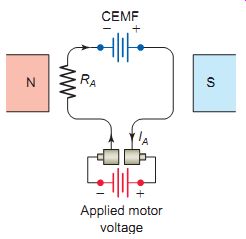
Ill. 23 Motor CEMF. Applied motor voltage
Motor Counter Electromotive Force (CEMF)
As the armature rotates in a DC motor, the armature coils cut the magnetic field of the stator and induce a voltage, or electromotive force (EMF), in these coils. This occurs in a motor as a by-product of motor rotation and is sometimes referred to as the generator action of a motor. Because this induced voltage opposes the applied terminal voltage, it’s called counter electromotive force, or CEMF. Counter EMF (sometimes referred to as back EMF) is a form of resistance that opposes and limits the flow of armature current.
The overall effect of the CEMF is that this voltage will be subtracted from the terminal voltage of the motor so that the armature motor winding will see a smaller voltage potential. Counter EMF is equal to the applied voltage minus the armature circuit IARA drop. The armature current, according to Ohm's law, is equal to:
IA = VMTR – CEMF/RA
where IA = armature current
V MTR = motor terminal voltage
CEMF = counter electromotive force
RA = armature-circuit resistance
==
EXAMPLE 1
Problem: The armature of a 250-V DC motor draws 15 A when operating at full load and has a resistance of 2 ohm. Determine the counter EMF produced by the armature when operating at full load.
Solution:
I A= V MTR – CEMF/R A
CEMF = V MTR - ( I A × R A) = 250 V - (15 A × 2 ?)
= 250 - 30 = 220 V
==
Counter EMF is directly proportional to the speed of the armature and the field strength. That is, the counter EMF increases or decreases if the speed is increased or decreased, respectively. The same is true if the field strength is increased or decreased. At the moment a motor starts, the armature is not rotating, so there is no CEMF generated in the armature. Full line voltage is applied across the armature, and it draws a relatively large amount of current. At this point, the only factor limiting current through the armature is the relatively low resistance of the windings. As the motor picks up speed, a counter electromotive force is generated in the armature, which opposes the applied terminal voltage and quickly reduces the amount of armature current.
When a motor reaches its full no-load speed, it’s designed to be generating a CEMF nearly equal to the applied line voltage. Only enough current can flow to maintain this speed. When a load is applied to the motor, its speed will be decreased, which will reduce the CEMF, and more current will be drawn by the armature to drive the load. Thus, the load of a motor regulates the speed by affecting the CEMF and current flow.
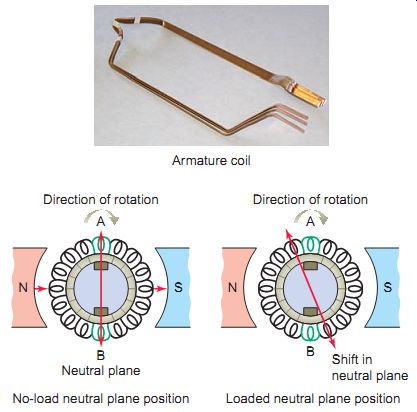
Ill. 24 Position of the neutral plane under no-load and loaded motor
operating conditions. Armature coil Direction of rotation Direction of
rotation; Neutral plane; No-load neutral plane position neutral plane;
Loaded neutral plane position
Armature Reaction
The magnetic field produced by current flow through the armature conductors distorts and weakens the flux coming from the main field poles. This distortion and field weakening of the stator field of the motor are known as armature reaction. Ill. 24 shows the position of the neutral plane under no-load and loaded motor operating conditions. As segment after segment of the rotating commutator pass under a brush, the brush short-circuits coil after coil in the armature. Note that armature coils A and B are positioned relative to the brushes so that at the instant each is short-circuited, it’s moving parallel to the main field so that there is no voltage induced in them at this point. When operating under loaded conditions, due to armature reaction, the neutral plane is shifted backward, opposing the direction of rotation. As a result armature reaction affects the motor operation by:
• Shifting the neutral plane in a direction opposite to the direction of rotation of the armature.
• Reducing motor torque as a result of the weakening of the magnetic field.
• Arcing at the brushes due to short-circuiting of the voltage being induced in the coils undergoing commutation
When the load on the motor fluctuates, the neutral plane shifts back and forth between no-load and full-load positions.
For small DC motors, the brushes are set in an intermediate position to produce acceptable commutation at all loads.
In larger DC motors, interpoles (also called commutating poles) are placed between the main field poles, to minimize the effects of armature reaction. These narrow poles have a few turns of larger-gauge wire connected in series with the armature. The strength of the interpole field varies with the armature current. The magnetic field generated by the interpoles is designed to be equal to and opposite that produced by the armature reaction for all values of load current and improves commutation.
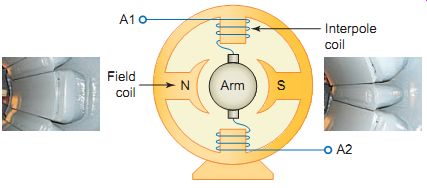
Ill. 25 Interpoles are placed between the main field poles. Interpole
coil
Speed Regulation
Motor speed regulation is a measure of a motor's ability to maintain its speed from no-load to full-load without a change in the applied voltage to the armature or fields. A motor has good speed regulation if the change between the no-load speed and full-load speed is small, with other conditions being constant. As an example, if the speed regulation is 3 % for a motor rated 1500 rpm with no load applied, then this means that the speed will drop by as much as 45 rpm (1500 × 3%) with the motor fully loaded. The speed regulation of a direct current motor is proportional to the armature resistance and is generally expressed as a percentage of the motor base speed. DC motors that have a very low armature resistance will have a better speed regulation. Speed regulation is the ratio of the loss in speed, between no load and full load, to the full-load speed and is calculated as follows (the lower the percentage, the better the speed regulation):
Percent speed regulation = No-load speed - Full-load speed/Full-load speed × 100
Varying DC Motor Speed
The base speed listed on a DC motor's nameplate is an indication of how fast the motor will run with rated armature voltage and rated load amperes at rated field current. DC motors can be operated below base speed by reducing the amount of voltage applied to the armature and above base speed by reducing the field cur rent. Additionally, the maximum motor speed may also be listed on the nameplate. Caution: Operating a motor above its rated maximum speed can cause damage to equipment and personnel. When only base speed is listed, check with the vendor before operating it above the specified speed.
Perhaps the greatest advantage of DC motors is speed control. In armature-controlled adjustable-speed applications, the field is connected across a constant-voltage sup ply and the armature is connected across an independent adjustable-voltage source. By raising or lowering the armature voltage, the motor speed will rise or fall proportionally. E.g., an unloaded motor might run at 1200 rpm with 250 V applied to the armature and 600 rpm with 125 V applied. Armature-controlled DC motors are capable of providing rated torque at any speed between zero and the base (rated) speed of the motor.
Horsepower varies in direct proportion to speed, and 100 % rated horsepower is developed only at 100 % rated motor speed with rated torque.
Shunt motors can be made to operate above base speed by field weakening. The motor is normally started with maxi mum field current to provide maximum flux for maximum starting torque. Decreasing the field current weakens the flux, and causes the speed to rise. Also, a reduction in field current will result in less generated counter EMF and a larger armature current flow for a given motor load. A simple method for controlling field is to insert a resistor in series with the field voltage source. This may be useful for trimming to an ideal motor speed for the application. An optional, more sophisticated method uses a variable-voltage field source.
Coordinated armature and field voltage control for extended speed range is illustrated. First the motor is armature voltage-controlled for constant torque, variable-horsepower operation up to base speed.
Once base speed is reached, field-weakening control is applied for constant-horsepower, variable-torque operation to the motor's maximum rated speed. Caution: If a DC motor suffers a loss of field excitation current while operating, the motor will immediately begin to accelerate to the top speed that the loading will allow. This can result in the motor virtually flying apart if it’s lightly loaded.
For this reason some form of field loss protection must be provided in the motor control circuit that will automatically stop the motor in the event that current to the field circuit is lost or drops below a safe value.
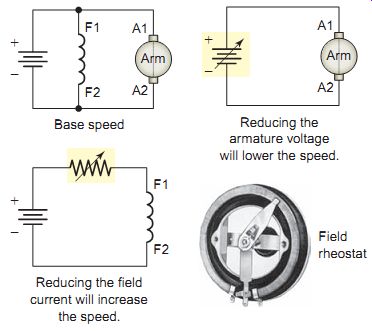
Ill. 26 DC motor speed. Base speed; Reducing the armature voltage will
lower the speed. Reducing the field current will increase the speed. Field
rheostat
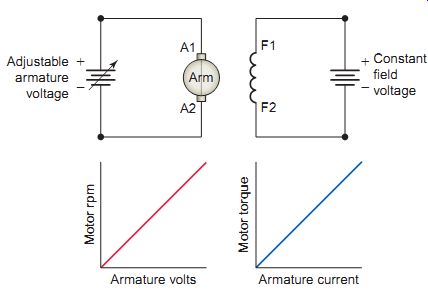
Ill. 27 Armature-controlled DC motor. Motor rpm Armature volts; Motor
torque; Armature current
Constant field voltage
Adjustable armature voltage; Arm

Ill. 28 Armature- and field-controlled DC motor. Constant torque-variable
horsepower (rated field excitation); Constant horsepower-variable torque
(weakened field excitation)
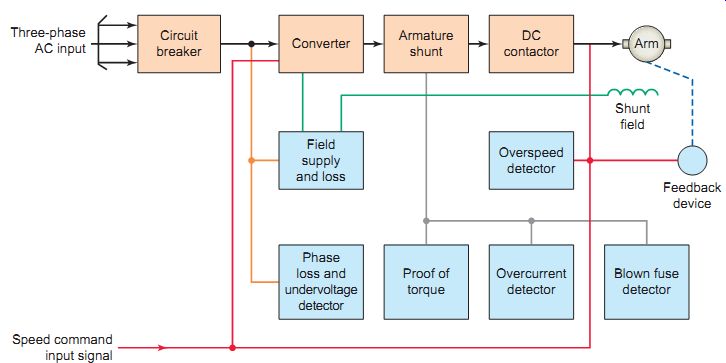
Ill. 29 The block diagram for a typical DC motor drive.
Three-phase AC input: Circuit breaker; Converter; Armature shunt; DC contactor; Arm
Speed command input signal: Feedback device; Field supply and loss; Overspeed detector; Proof of torque; Overcurrent detector; Blown fuse detector; Phase loss and undervoltage detector
DC Motor Drives
In general DC magnetic motor starters are intended to start and accelerate motors to normal speed and to provide protection against overloads. Unlike motor starters, motor drives are designed to provide, in addition to protection, precise control of the speed, torque, acceleration, deceleration, and direction of rotation of motors. Additionally, many motor drive units are capable of high-speed communication with programmable logic controller (PLCs) and other industrial controllers.
A motor drive is essentially an electronic device that uses different types of solid-state control techniques. A subsequent section on power electronics will examine how these solid-state devices operate. Ill. 29 shows the block diagram for a typical DC electronic variable-speed motor drive. This drive is made up of two basic sections: the power section and the control section. The operation of the drive system can be summarized as follows:
• Controlled power to the DC motor is supplied from the power section, consisting of the circuit breaker, converter, armature shunt, and DC contactor.
• The converter rectifies the three-phase AC power, converting it to DC for the DC motor.
• Attaining precise control of the motor requires a means of evaluating the motor's performance and automatically compensating for any variations from the desired levels. This is the job of the control section, which is made up of the speed command input signal as well as various feedback and error signals that are used to control the output of the power section.
DC motor drives use a separately excited shunt field because of the need to vary the armature voltage or the field current. When you vary the armature voltage, the motor produces full torque but the speed is varied. However, when the field current is varied, both the motor speed and the torque will vary. Ill. 30 shows a typical DC motor drive unit used to provide very precise control over the operation of a conveyor system. In addition to managing motor speed and torque, it provides controlled acceleration and deceleration as well as forward and reverse motor operation.
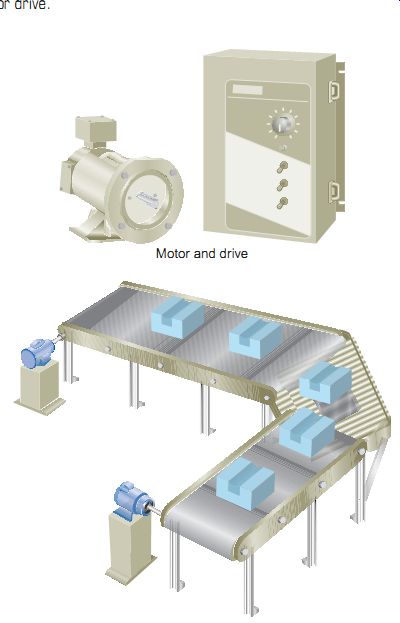
Ill. 30 Typical DC motor drive unit. Motor and drive
QUIZ:
1. Give two reasons why DC motors are seldom the first motor of choice for most applications.
2. What special types of processes may warrant the use of a DC motor?
3. Explain the function of the commutator in the operation of a DC motor.
4. a. How is the direction of rotation of a permanent magnet motor changed?
b. How is the speed of a permanent-magnet motor controlled?
5. Summarize the torque and speed characteristics of a DC series motor.
6. Why should a DC series motor not be operated without some sort of a load coupled to it?
7. In what way is the shunt field winding of a shunt motor different from that of the series field winding of a series motor?
8. Compare the starting torque and load versus speed characteristics of the series motor to those of shunt wound motor.
9. How are the series and shunt field windings of the compound wound DC motor connected relative to the armature?
10. In what way is a cumulative-compound motor connected?
11. Compare the torque and speed characteristics of a compound motor with those of the series and shunt motors.
12. How can the direction of rotation of a wound DC motor be changed?
13. Explain how counter EMF is produced in a DC motor.
14. A 5-hp, 230-V DC motor has an armature resistance of 0.1 ohm and a full-load armature current of 20 A. Determine:
a. the value of the armature current on starting.
b. the value of the counter EMF with full-load applied.
15. a. What is motor armature reaction?
b. State three effects that armature reaction has on the operation of a DC motor.
16. Explain how interpoles minimize the effects of armature reaction.
17. a. A motor rated for 1750 rpm at no load has a 4 % speed regulation. Calculate the speed of the motor with full load applied.
b. In what way does a DC motor's armature resistance affect its speed regulation?
18. a. How is the base speed of a DC motor defined?
b. How is the speed of a DC motor controlled below base speed?
c. How is the speed of a DC motor controlled above base speed?
19. With armature voltage control of a DC shunt motor, what is the effect on the rated torque and horse power when the armature voltage is increased?
20. With field current control of a shunt DC motor, what is the effect on the rated torque and horse power when the armature voltage is increased?
21. Field loss protection must be provided for DC motors. Why?
22. List several control functions found on a DC motor drive that would not normally be provided by a traditional DC magnetic motor starter.
Cont. to part 3